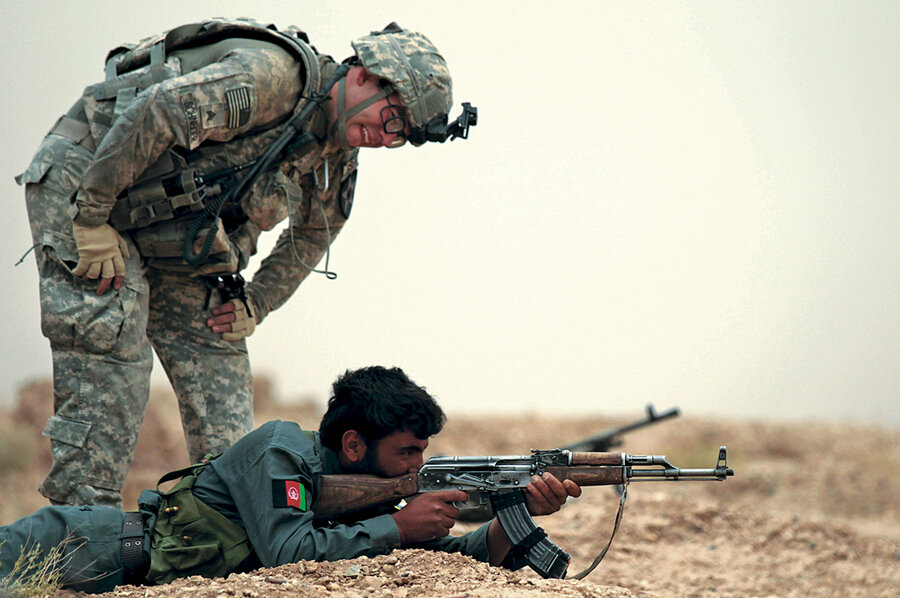Afghanistan surge: Is the 'clear, hold, build' strategy working?
Loading...
| Washington
The surge of American forces President Obama directed to Afghanistan is under way. So far, 17,000 of the 30,000 additional forces are there, bringing the US total in Afghanistan to 86,000. The rest are expected on the ground by December, for a total of 100,000.
How have things been progressing so far, and what can be expected during the next year?
Has the surge had an impact yet?
The increase of Marine forces enabled the United States to conduct operations in the Marjah district of Helmand Province this winter, the first operation since the beginning of the surge. The Marjah offensive drove out some insurgents and tempered their influence in the area, at least somewhat.
In Afghanistan, where progress is expected to be incremental, the offensive has been seen as a success. In the wake of initial operations, markets opened, villagers returned, and some semblance of security emerged.
The next major operation is now beginning in Kandahar, arguably the second most important cultural, political, and economic city in Afghanistan after Kabul, and considered the spiritual home of the Taliban.
Those operations have begun quietly in recent weeks as more surge forces arrive.
How will the surge be different from the first eight years of the war?
The Marjah offensive offered clues. It employed some key new strategies that will be implemented by surge forces.
First, in an effort to encourage insurgents to leave, coalition forces telegraphed their intentions very publicly. It worked. For the most part, the offensive was anticlimactic. Insurgents either left or went into hiding as the US and coalition forces arrived. This points to the coalition's shift from an emphasis on killing insurgents to protecting populations.
After arriving, coalition forces essentially built a ring around the area. This contrasts with many presurge offenses, in which troops attacked and then mostly returned to their bases.
The goal of the surge is to "clear" key population centers of insurgents, then "hold" them to prevent insurgents from returning. The next step is to maintain law and order to allow Afghans to "build" normal lives. This is called a "clear, hold, build" strategy, which US forces also used in Iraq.
What does the Iraq surge tell us about what might happen in Afghanistan?
During the surge of forces in Iraq, which began in early 2007, the number of US casualties swelled. In January 2007, for example, there were 137,000 troops in Iraq and 86 coalition fatalities, according to icasualties.org. By May 2007, there were 148,000 American troops on the ground and 131 coalition fatalities.
But that trend started to change when certain factors converged to help stabilize Iraq. One of those factors, many experts argue, was that the increasing number of troops created a critical mass to help stem the violence.
By October, there were 166,000 American troops in Iraq, but the number of fatalities per month had dropped to 40.
Afghanistan may be considerably different, and experts and military officials are reluctant to predict that the surge will work the same way in two distinctly different places.
Iraq's relative homogeneity stands in stark contrast to the tribal and ethnic diversity of Afghanistan, where few village elders think alike, and are motivated by different things. One village leader might want money for a new school, another might want the US to vacate an area to give him more credibility.
Are US forces working to co-opt local forces as they did in Iraq with the 'Anbar Awakening'?
Not in any comprehensive way. The Pentagon has been pushing the small triumphs of its Local Defense Initiative, which attempts to leverage tribal militias into anti-insurgent "neighborhood watches."
But Kabul has pushed back against the initiative, fearing that the arming and promotion of local militias could lead to a civil war similar to the one that engulfed Afghanistan after the Soviets left and which led to the rise of the Taliban.
With the Americans wanting to have an Afghan face on everything they do, they are wary of going against Kabul's wishes. President Hamid Karzai plans to hold a "peace jirga" to bring together different leaders. Out of that a "Sons of Afghanistan"-like program could emerge. But it may still be too soon.
Related:





